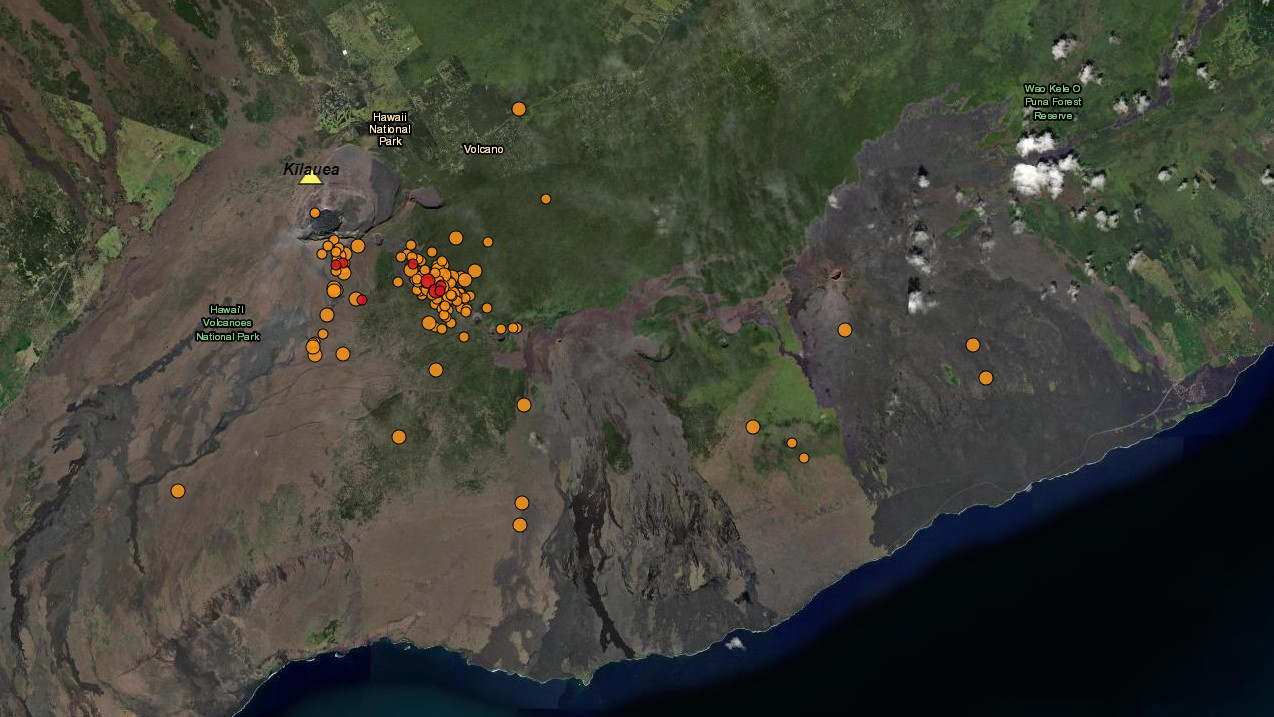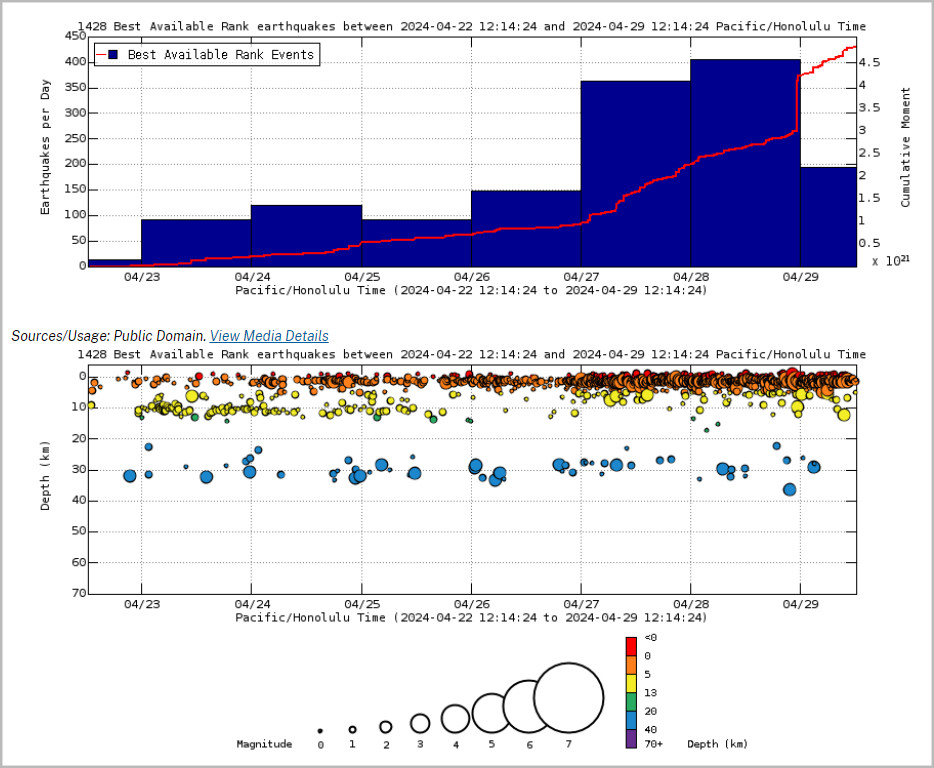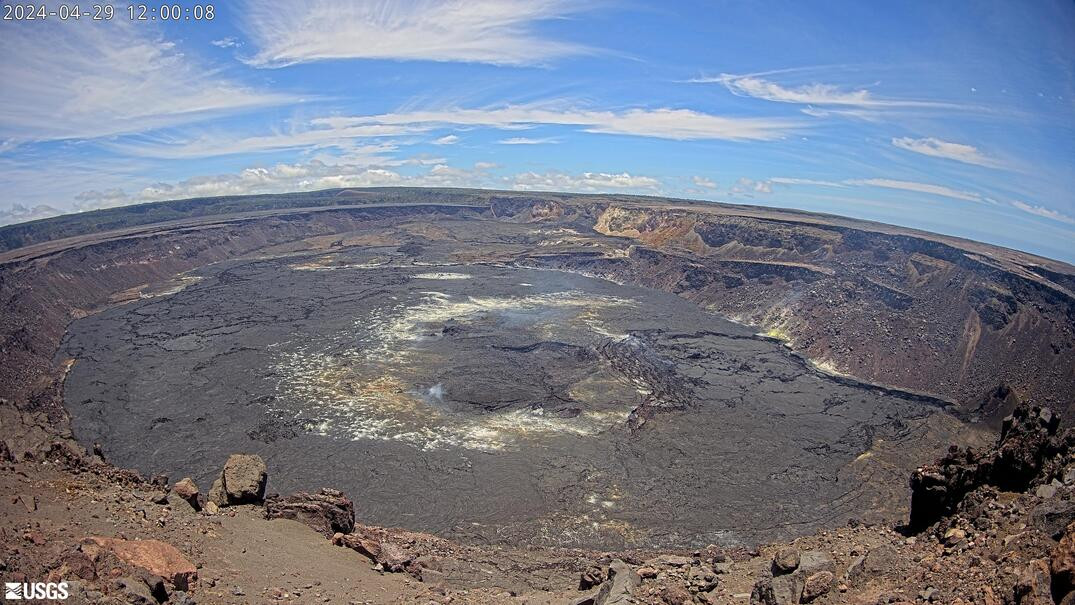(BIVN) – Kīlauea volcano is not erupting, however there has been a significant increase in seismicity beneath the upper East Rift Zone and caldera south of Halemaʻumaʻu.
The Hawaiʻi island volcano entered a heightened state of unrest in the early morning of April 27th, and that state of unrest is continuing and has intensified, scientists say. There have been over 360 earthquakes in the past 24 hours, compared to 250 earthquakes in the previous 24 hours. The earthquakes are located mostly beneath the upper East Rift Zone with fewer in the caldera south of Halemaʻumaʻu.

from interactive USGS map showing the location of the earthquakes, mostly beneath the upper East Rift Zone with fewer in the caldera south of Halemaʻumaʻu
“At this time, it is not possible to say with certainty if this increase in activity will lead to an eruption in the near future – or simply remain confined below ground,” wrote the USGS Hawaiian Volcano Observatory in a Monday report. “However, the gradual strengthening of seismic swarms suggests that an eruption in Kīlauea’s summit region or beneath the upper East Rift Zone, within Hawai‘i Volcanoes National Park, is one potential outcome.”
The uptick in activity has prompted some closures within Hawaiʻi Volcanoes National Park. Hilina Pali Road is closed from Chain of Craters Road, and overnight use of the coastal backcountry, Nāpau and Pepeiao Cabin is temporarily suspended.
The current USGS Volcano Alert Level for Kīlauea remains at ADVISORY. All seismic activity on the East Rift Zone is confined to the upper East Rift Zone, with no significant earthquakes or deformation occurring past the Mauna Ulu region.

From USGS: Earthquake Rates and Depths as of noon on Monday. Above Top: Number of earthquakes per day during the past week (blue bars). The red line is the cumulative moment (energy) release. Bottom: Depth of earthquakes during the past week in the area shown on the map above. Depth is reported relative to sea level, which is equal to a depth of zero on the above plot. On both figures, circle-size represents magnitude, and color indicates depth.
From Monday’s update by the USGS HVO:
Summit and upper East Rift Zone Observations: Earthquake activity increased sharply just after midnight on April 27 beneath the upper East Rift Zone (between Puhimau Crater and Hilina Pali road) and beneath Kīlauea caldera south of Halemaʻumaʻu. Earthquakes are occurring at depths of 1.5-2.5 km (1-1.5 miles) beneath the surface. Activity intensified yesterday and there have been over 360 earthquakes in the past 24 hours compared to 250 earthquakes in the previous 24 hours mostly beneath the upper East Rift Zone with fewer in the caldera south of Halemaʻumaʻu. In addition, the intensity of activity increased just after 11 p.m. on April 28, when several strong earthquakes including a magnitude 3.3 set off a swarm of earthquakes beneath the upper East Rift Zone that lasted for about 45 minutes. Activity returned to frequent small earthquakes less than magnitude 2 punctuated by occasional larger earthquakes with magnitudes between 2 and 3. The deeper earthquakes that were occurring 5-10 km (3-6 miles) directly beneath Kīlauea caldera over the past few weeks have ceased.
Kīlauea’s summit remains inflated. Overall ground deformation continues, with ongoing inflation of the summit and uplift south of the caldera. Tiltmeters near Uēkahuna and Sand Hill showed decreased rates of inflation and uplift on the evening of April 27 with the onset of a deflation-inflation (DI) event. The intense swarm of earthquakes recorded between 11 p.m. and midnight last night (April 28) coincided with increased inflation recorded on the Uēkahuna tiltmeter associated with the inflationary end of the DI event that began the previous day. Inflation at both tiltmeters returned to lower rates along with the seismicity just before midnight on April 28. Sulfur dioxide (SO2) gas emission rates remain low. An SO2 emission rate of approximately 52 tonnes per day was recorded on April 23.
Rift Zone Observations: All seismic activity on the East Rift Zone is confined to the upper East Rift Zone, with no significant earthquakes or deformation occurring past the Mauna Ulu region. Seismicity in Kīlauea’s Southwest Rift Zone remains low overall. Measurements from continuous gas monitoring stations downwind of Puʻuʻōʻō in the middle East Rift Zone—the site of 1983–2018 eruptive activity—continue to be below detection limits for SO2, indicating that SO2 emissions Puʻuʻōʻō are negligible.
The USGS HVO says it will continue to provide daily updates while the volcanic unrest continues.


by Big Island Video News12:27 pm
on at
STORY SUMMARY
HAWAIʻI VOLCANOES NATIONAL PARK - The increased seismicity beneath the upper East Rift Zone and caldera south of Halemaʻumaʻu is continuing and has intensified.